Yuxiang Guo
Snoopy: Effective and Efficient Semantic Join Discovery via Proxy Columns
Feb 24, 2025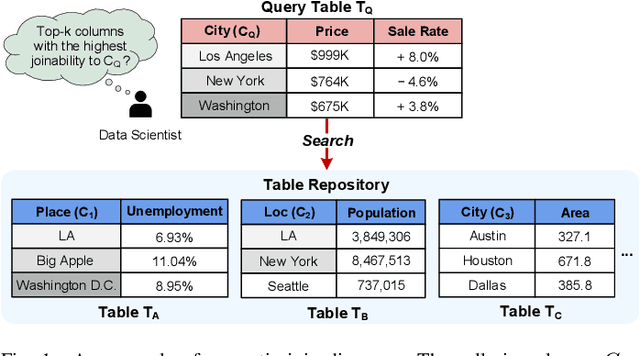
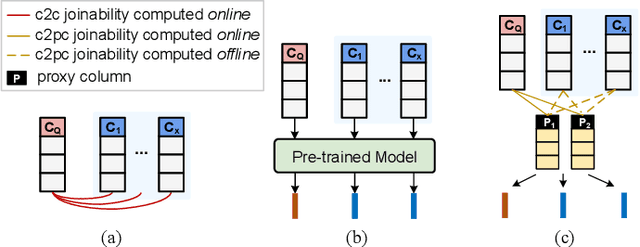
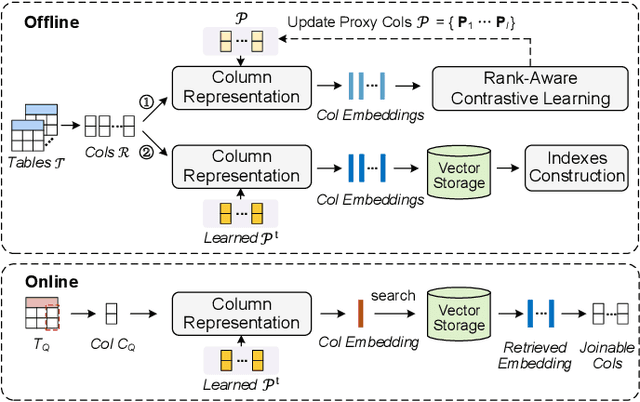
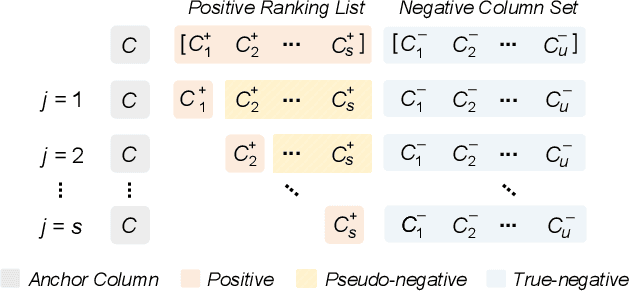
Abstract:Semantic join discovery, which aims to find columns in a table repository with high semantic joinabilities to a query column, is crucial for dataset discovery. Existing methods can be divided into two categories: cell-level methods and column-level methods. However, neither of them ensures both effectiveness and efficiency simultaneously. Cell-level methods, which compute the joinability by counting cell matches between columns, enjoy ideal effectiveness but suffer poor efficiency. In contrast, column-level methods, which determine joinability only by computing the similarity of column embeddings, enjoy proper efficiency but suffer poor effectiveness due to the issues occurring in their column embeddings: (i) semantics-joinability-gap, (ii) size limit, and (iii) permutation sensitivity. To address these issues, this paper proposes to compute column embeddings via proxy columns; furthermore, a novel column-level semantic join discovery framework, Snoopy, is presented, leveraging proxy-column-based embeddings to bridge effectiveness and efficiency. Specifically, the proposed column embeddings are derived from the implicit column-to-proxy-column relationships, which are captured by the lightweight approximate-graph-matching-based column projection.To acquire good proxy columns for guiding the column projection, we introduce a rank-aware contrastive learning paradigm. Extensive experiments on four real-world datasets demonstrate that Snoopy outperforms SOTA column-level methods by 16% in Recall@25 and 10% in NDCG@25, and achieves superior efficiency--being at least 5 orders of magnitude faster than cell-level solutions, and 3.5x faster than existing column-level methods.
An Immersive Multi-Elevation Multi-Seasonal Dataset for 3D Reconstruction and Visualization
Dec 19, 2024Abstract:Significant progress has been made in photo-realistic scene reconstruction over recent years. Various disparate efforts have enabled capabilities such as multi-appearance or large-scale modeling; however, there lacks a welldesigned dataset that can evaluate the holistic progress of scene reconstruction. We introduce a collection of imagery of the Johns Hopkins Homewood Campus, acquired at different seasons, times of day, in multiple elevations, and across a large scale. We perform a multi-stage calibration process, which efficiently recover camera parameters from phone and drone cameras. This dataset can enable researchers to rigorously explore challenges in unconstrained settings, including effects of inconsistent illumination, reconstruction from large scale and from significantly different perspectives, etc.
SPARS3R: Semantic Prior Alignment and Regularization for Sparse 3D Reconstruction
Nov 15, 2024



Abstract:Recent efforts in Gaussian-Splat-based Novel View Synthesis can achieve photorealistic rendering; however, such capability is limited in sparse-view scenarios due to sparse initialization and over-fitting floaters. Recent progress in depth estimation and alignment can provide dense point cloud with few views; however, the resulting pose accuracy is suboptimal. In this work, we present SPARS3R, which combines the advantages of accurate pose estimation from Structure-from-Motion and dense point cloud from depth estimation. To this end, SPARS3R first performs a Global Fusion Alignment process that maps a prior dense point cloud to a sparse point cloud from Structure-from-Motion based on triangulated correspondences. RANSAC is applied during this process to distinguish inliers and outliers. SPARS3R then performs a second, Semantic Outlier Alignment step, which extracts semantically coherent regions around the outliers and performs local alignment in these regions. Along with several improvements in the evaluation process, we demonstrate that SPARS3R can achieve photorealistic rendering with sparse images and significantly outperforms existing approaches.
TODO: Enhancing LLM Alignment with Ternary Preferences
Nov 02, 2024



Abstract:Aligning large language models (LLMs) with human intent is critical for enhancing their performance across a variety of tasks. Standard alignment techniques, such as Direct Preference Optimization (DPO), often rely on the binary Bradley-Terry (BT) model, which can struggle to capture the complexities of human preferences -- particularly in the presence of noisy or inconsistent labels and frequent ties. To address these limitations, we introduce the Tie-rank Oriented Bradley-Terry model (TOBT), an extension of the BT model that explicitly incorporates ties, enabling more nuanced preference representation. Building on this, we propose Tie-rank Oriented Direct Preference Optimization (TODO), a novel alignment algorithm that leverages TOBT's ternary ranking system to improve preference alignment. In evaluations on Mistral-7B and Llama 3-8B models, TODO consistently outperforms DPO in modeling preferences across both in-distribution and out-of-distribution datasets. Additional assessments using MT Bench and benchmarks such as Piqa, ARC-c, and MMLU further demonstrate TODO's superior alignment performance. Notably, TODO also shows strong results in binary preference alignment, highlighting its versatility and potential for broader integration into LLM alignment. The implementation details can be found in https://github.com/XXares/TODO.
StimuVAR: Spatiotemporal Stimuli-aware Video Affective Reasoning with Multimodal Large Language Models
Aug 31, 2024Abstract:Predicting and reasoning how a video would make a human feel is crucial for developing socially intelligent systems. Although Multimodal Large Language Models (MLLMs) have shown impressive video understanding capabilities, they tend to focus more on the semantic content of videos, often overlooking emotional stimuli. Hence, most existing MLLMs fall short in estimating viewers' emotional reactions and providing plausible explanations. To address this issue, we propose StimuVAR, a spatiotemporal Stimuli-aware framework for Video Affective Reasoning (VAR) with MLLMs. StimuVAR incorporates a two-level stimuli-aware mechanism: frame-level awareness and token-level awareness. Frame-level awareness involves sampling video frames with events that are most likely to evoke viewers' emotions. Token-level awareness performs tube selection in the token space to make the MLLM concentrate on emotion-triggered spatiotemporal regions. Furthermore, we create VAR instruction data to perform affective training, steering MLLMs' reasoning strengths towards emotional focus and thereby enhancing their affective reasoning ability. To thoroughly assess the effectiveness of VAR, we provide a comprehensive evaluation protocol with extensive metrics. StimuVAR is the first MLLM-based method for viewer-centered VAR. Experiments demonstrate its superiority in understanding viewers' emotional responses to videos and providing coherent and insightful explanations.
SCCA: Shifted Cross Chunk Attention for long contextual semantic expansion
Dec 12, 2023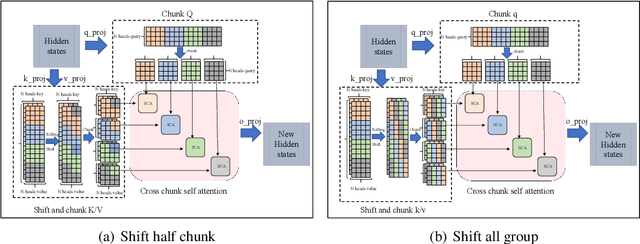
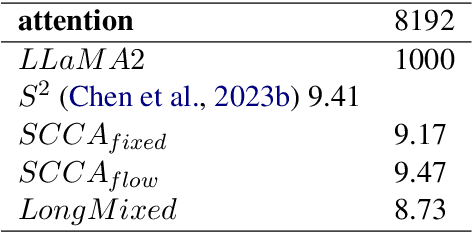
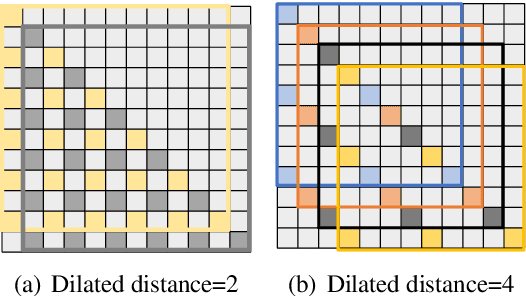

Abstract:Sparse attention as a efficient method can significantly decrease the computation cost, but current sparse attention tend to rely on window self attention which block the global information flow. For this problem, we present Shifted Cross Chunk Attention (SCCA), using different KV shifting strategy to extend respective field in each attention layer. Except, we combine Dilated Attention(DA) and Dilated Neighborhood Attention(DNA) to present Shifted Dilated Attention(SDA). Both SCCA and SDA can accumulate attention results in multi head attention to obtain approximate respective field in full attention. In this paper, we conduct language modeling experiments using different pattern of SCCA and combination of SCCA and SDA. The proposed shifted cross chunk attention (SCCA) can effectively extend large language models (LLMs) to longer context combined with Positional interpolation(PI) and LoRA than current sparse attention. Notably, SCCA adopts LLaMA2 7B from 4k context to 8k in single V100. This attention pattern can provide a Plug-and-play fine-tuning method to extend model context while retaining their original architectures, and is compatible with most existing techniques.
GaitContour: Efficient Gait Recognition based on a Contour-Pose Representation
Nov 27, 2023Abstract:Gait recognition holds the promise to robustly identify subjects based on walking patterns instead of appearance information. In recent years, this field has been dominated by learning methods based on two principal input representations: dense silhouette masks or sparse pose keypoints. In this work, we propose a novel, point-based Contour-Pose representation, which compactly expresses both body shape and body parts information. We further propose a local-to-global architecture, called GaitContour, to leverage this novel representation and efficiently compute subject embedding in two stages. The first stage consists of a local transformer that extracts features from five different body regions. The second stage then aggregates the regional features to estimate a global human gait representation. Such a design significantly reduces the complexity of the attention operation and improves efficiency and performance simultaneously. Through large scale experiments, GaitContour is shown to perform significantly better than previous point-based methods, while also being significantly more efficient than silhouette-based methods. On challenging datasets with significant distractors, GaitContour can even outperform silhouette-based methods.
Instruct2Attack: Language-Guided Semantic Adversarial Attacks
Nov 27, 2023Abstract:We propose Instruct2Attack (I2A), a language-guided semantic attack that generates semantically meaningful perturbations according to free-form language instructions. We make use of state-of-the-art latent diffusion models, where we adversarially guide the reverse diffusion process to search for an adversarial latent code conditioned on the input image and text instruction. Compared to existing noise-based and semantic attacks, I2A generates more natural and diverse adversarial examples while providing better controllability and interpretability. We further automate the attack process with GPT-4 to generate diverse image-specific text instructions. We show that I2A can successfully break state-of-the-art deep neural networks even under strong adversarial defenses, and demonstrate great transferability among a variety of network architectures.
A study on the impact of pre-trained model on Just-In-Time defect prediction
Sep 05, 2023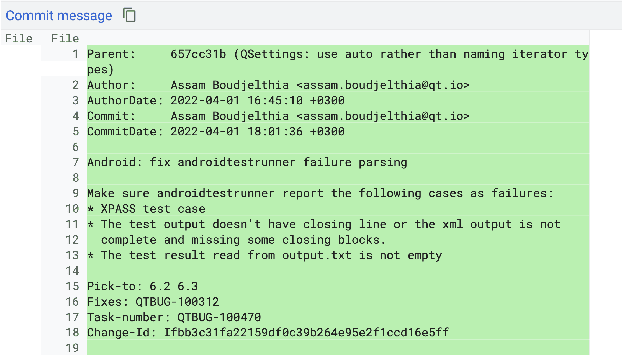
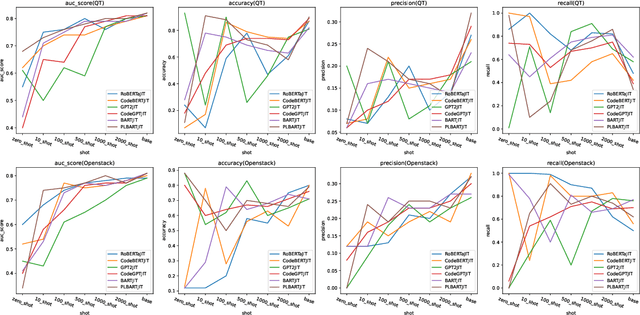
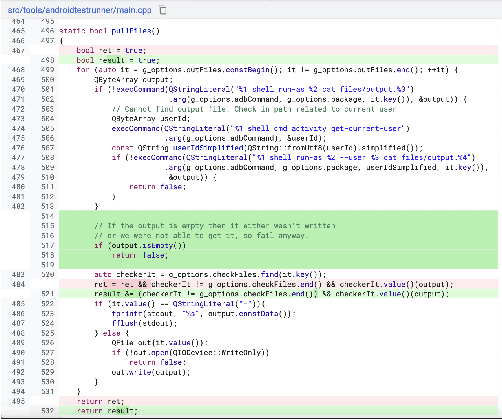
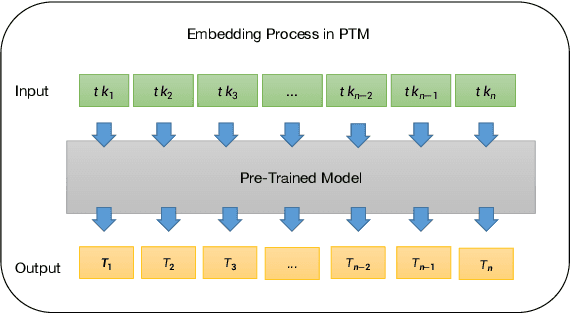
Abstract:Previous researchers conducting Just-In-Time (JIT) defect prediction tasks have primarily focused on the performance of individual pre-trained models, without exploring the relationship between different pre-trained models as backbones. In this study, we build six models: RoBERTaJIT, CodeBERTJIT, BARTJIT, PLBARTJIT, GPT2JIT, and CodeGPTJIT, each with a distinct pre-trained model as its backbone. We systematically explore the differences and connections between these models. Specifically, we investigate the performance of the models when using Commit code and Commit message as inputs, as well as the relationship between training efficiency and model distribution among these six models. Additionally, we conduct an ablation experiment to explore the sensitivity of each model to inputs. Furthermore, we investigate how the models perform in zero-shot and few-shot scenarios. Our findings indicate that each model based on different backbones shows improvements, and when the backbone's pre-training model is similar, the training resources that need to be consumed are much more closer. We also observe that Commit code plays a significant role in defect detection, and different pre-trained models demonstrate better defect detection ability with a balanced dataset under few-shot scenarios. These results provide new insights for optimizing JIT defect prediction tasks using pre-trained models and highlight the factors that require more attention when constructing such models. Additionally, CodeGPTJIT and GPT2JIT achieved better performance than DeepJIT and CC2Vec on the two datasets respectively under 2000 training samples. These findings emphasize the effectiveness of transformer-based pre-trained models in JIT defect prediction tasks, especially in scenarios with limited training data.
GADER: GAit DEtection and Recognition in the Wild
Jul 27, 2023



Abstract:Gait recognition holds the promise of robustly identifying subjects based on their walking patterns instead of color information. While previous approaches have performed well for curated indoor scenes, they have significantly impeded applicability in unconstrained situations, e.g. outdoor, long distance scenes. We propose an end-to-end GAit DEtection and Recognition (GADER) algorithm for human authentication in challenging outdoor scenarios. Specifically, GADER leverages a Double Helical Signature to detect the fragment of human movement and incorporates a novel gait recognition method, which learns representations by distilling from an auxiliary RGB recognition model. At inference time, GADER only uses the silhouette modality but benefits from a more robust representation. Extensive experiments on indoor and outdoor datasets demonstrate that the proposed method outperforms the State-of-The-Arts for gait recognition and verification, with a significant 20.6% improvement on unconstrained, long distance scenes.
 Add to Chrome
Add to Chrome Add to Firefox
Add to Firefox Add to Edge
Add to Edge